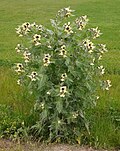Hyoscyamus niger
Hyoscyamus niger is a plant species native to Europe, Asia, and North Africa. It is commonly known as henbane, black henbane, or stinking nightshade. This plant is notable for its medicinal properties and its use in traditional medicine.
Description[edit]
Hyoscyamus niger is a biennial or perennial plant, growing up to 1 meter tall. The leaves are alternate, simple, and entire or sinuate. The flowers are solitary in the axils of the leaves, with a five-lobed calyx and corolla. The fruit is a capsule.
Distribution and habitat[edit]
Hyoscyamus niger is native to Europe, Asia, and North Africa. It is typically found in sandy soils, waste places, and near the sea.
Uses[edit]
Hyoscyamus niger has been used in traditional medicine for its sedative and antispasmodic properties. It contains several alkaloids, including hyoscyamine and scopolamine, which have been used to treat a variety of conditions, including gastrointestinal disorders, respiratory disorders, and neurological disorders.
Toxicity[edit]
Despite its medicinal uses, Hyoscyamus niger is also highly toxic and can cause serious side effects, including hallucinations, delirium, and even death. It should be used with caution and under the supervision of a healthcare professional.
See also[edit]
References[edit]
<references />
External links[edit]
- Hyoscyamus niger at WikiMD
Ad. Transform your life with W8MD's Budget GLP-1 injections from $75


W8MD offers a medical weight loss program to lose weight in Philadelphia. Our physician-supervised medical weight loss provides:
- Weight loss injections in NYC (generic and brand names):
- Zepbound / Mounjaro, Wegovy / Ozempic, Saxenda
- Most insurances accepted or discounted self-pay rates. We will obtain insurance prior authorizations if needed.
- Generic GLP1 weight loss injections from $75 for the starting dose.
- Also offer prescription weight loss medications including Phentermine, Qsymia, Diethylpropion, Contrave etc.
NYC weight loss doctor appointmentsNYC weight loss doctor appointments
Start your NYC weight loss journey today at our NYC medical weight loss and Philadelphia medical weight loss clinics.
- Call 718-946-5500 to lose weight in NYC or for medical weight loss in Philadelphia 215-676-2334.
- Tags:NYC medical weight loss, Philadelphia lose weight Zepbound NYC, Budget GLP1 weight loss injections, Wegovy Philadelphia, Wegovy NYC, Philadelphia medical weight loss, Brookly weight loss and Wegovy NYC
|
WikiMD's Wellness Encyclopedia |
| Let Food Be Thy Medicine Medicine Thy Food - Hippocrates |
Medical Disclaimer: WikiMD is not a substitute for professional medical advice. The information on WikiMD is provided as an information resource only, may be incorrect, outdated or misleading, and is not to be used or relied on for any diagnostic or treatment purposes. Please consult your health care provider before making any healthcare decisions or for guidance about a specific medical condition. WikiMD expressly disclaims responsibility, and shall have no liability, for any damages, loss, injury, or liability whatsoever suffered as a result of your reliance on the information contained in this site. By visiting this site you agree to the foregoing terms and conditions, which may from time to time be changed or supplemented by WikiMD. If you do not agree to the foregoing terms and conditions, you should not enter or use this site. See full disclaimer.
Credits:Most images are courtesy of Wikimedia commons, and templates, categories Wikipedia, licensed under CC BY SA or similar.
Translate this page: - East Asian
中文,
日本,
한국어,
South Asian
हिन्दी,
தமிழ்,
తెలుగు,
Urdu,
ಕನ್ನಡ,
Southeast Asian
Indonesian,
Vietnamese,
Thai,
မြန်မာဘာသာ,
বাংলা
European
español,
Deutsch,
français,
Greek,
português do Brasil,
polski,
română,
русский,
Nederlands,
norsk,
svenska,
suomi,
Italian
Middle Eastern & African
عربى,
Turkish,
Persian,
Hebrew,
Afrikaans,
isiZulu,
Kiswahili,
Other
Bulgarian,
Hungarian,
Czech,
Swedish,
മലയാളം,
मराठी,
ਪੰਜਾਬੀ,
ગુજરાતી,
Portuguese,
Ukrainian









